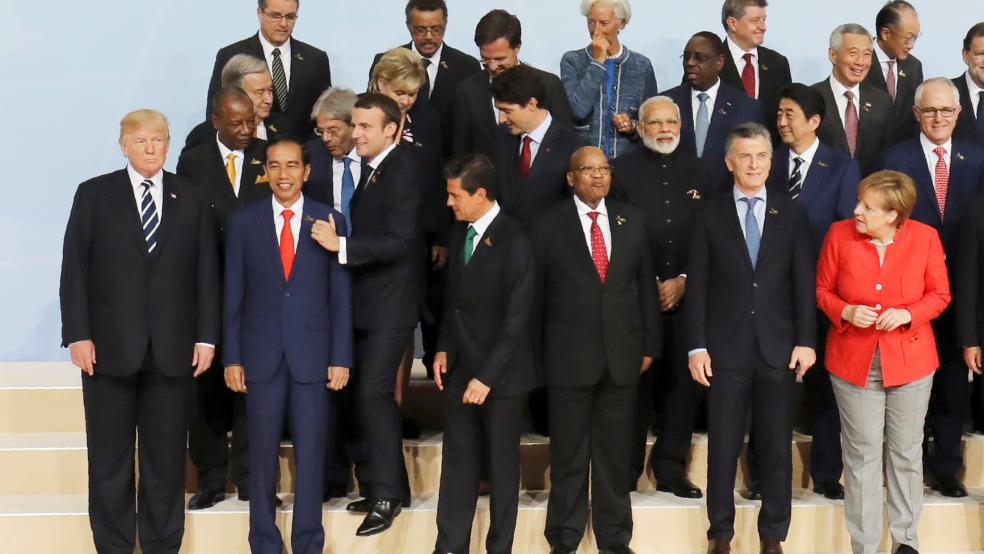The Trump administration has no coherent foreign policy, and the U.S. is paying the price for the President’s failure to figure out a post–Obama strategic framework.
Trump and many of his advisers don’t seem to understand the speed at which other nations are moving forward. Neither America’s allies nor its adversaries are waiting around to see what Trump’s policy priorities are and how he plans to pursue them. A string of events since Trump took office already indicates that the U.S. is starting to fall behind because it’s basically standing still.
Related: The Soul-Sucking Task of Defending Trump’s Incoherent Foreign Policy
Consider these developments:
• Nobody took much notice when Chinese President Xi Jinping stopped in Moscow to meet Vladimir Putin on their way to the Group of 20 Summit in Hamburg a couple of weeks ago.
The two signed investment contracts worth $10 billion and a raft of cooperation agreements while announcing a firm alliance to support a negotiated resolution on the Korean Peninsula—a clear commitment to counter Washington’s hard line. Putin described it as “a major event in bilateral relations.”
The meeting in Moscow is just the latest sign of ever-closer ties between China and Russia across a wide range of sectors, including energy, industrial investment, security, and military cooperation. Trump came to office thinking he would play the Chinese off the Russians to U.S. advantage, as Nixon and Kissinger once did. It’s clear now he has squandered what chance he may have had to make that work.
• Last week Japan and the European Union reached a trade agreement that could hardly send a clearer message to Washington: We’re still for free trade and getting on with it. The pact has been four years in negotiation, but nobody misses the significance of the timing: It comes a few months after Trump pulled out of the Trans–Pacific Partnership, leaving Japan and 10 other signatories dangling.
Related: How to Decode the Meeting Between Trump Jr. and the Russian Lawyer
The Japan–E.U. deal has a heavy focus on cars and car parts—a sector Trump has made a specific fuss about in his dealings with Tokyo. It also lowers Japanese tariffs on European meat and dairy products —markets U.S. negotiators have failed to open for decades.
Now the Japanese are talking about the E.U. accord as a stimulus for reviving the TTP —without the U.S.
• Japanese Premier Shinzo Abe traveled to Moscow a couple of months ago for a summit with Putin advertised as “business as usual.” It’s the 17th —yes, 17th — time in the past four years that the leader of Washington’s key Asian ally has met with the president of Washington’s No. 1 adversary.
A deal settling a territorial dispute dating to 1945 remains elusive. But progress toward normalized ties is unmistakable. The big move this time was an agreement to back a peaceful settlement of the Korea crisis. In effect, Abe just joined the camp of those opposed to Trump’s line on the Korea question.
• In the case of China, the Trump administration is flatly being outpaced. The U.S. still hasn’t joined the Beijing-sponsored Asian Infrastructure Investment Bank, a well-capitalized public-sector financing institution. (Two years late, it is reportedly negotiating membership.)
Related: China Flexes Its Naval Might as the North Korea Threat Intensifies
In May, when Xi held his grand “Belt and Road” summit, celebrating Beijing’s hugely ambitious plans to connect East Asia to the Middle East and Europe, the heads of state and cabinet ministers in attendance numbered in the dozens. The U.S. had no significant representation.
There’s a corollary here: Earlier this year China raised its hand up to help bankroll Syria’s reconstruction once a settlement is reached. That’s estimated to be a $1 trillion project; taking a piece of it would give China yet another foothold in an emerging-market nation.
These are substantive developments. And this list is very far from complete. The world turns—a lot faster than the Trump administration realizes.
It’s fine to say, as many have, that Trump damaged America’s leadership role when he withdrew from the Paris Agreement, which isolated and marginalized the U.S. at the G–20 in Hamburg. But it’s time to look beyond this abstraction and see how expensive the administration’s failure to construct a strategic framework is turning out to be.
It should be noted that none of the above-listed developments has anything to do with military deployment. Washington needs a game plan, fast, and one key part of it must be the right balance between military power on one side and political and economic engagement on the other.
It’s hard to argue that the administration is anywhere near on track.






